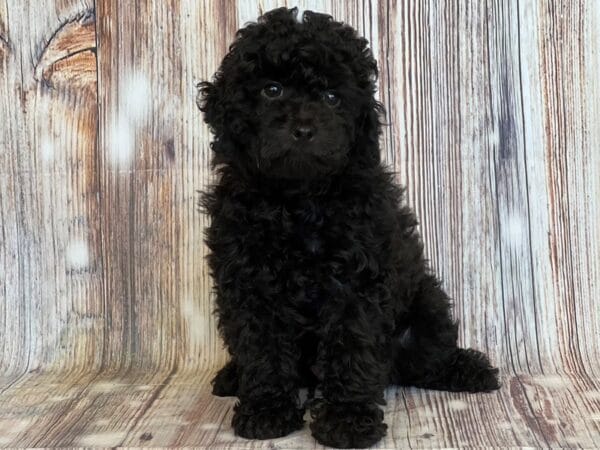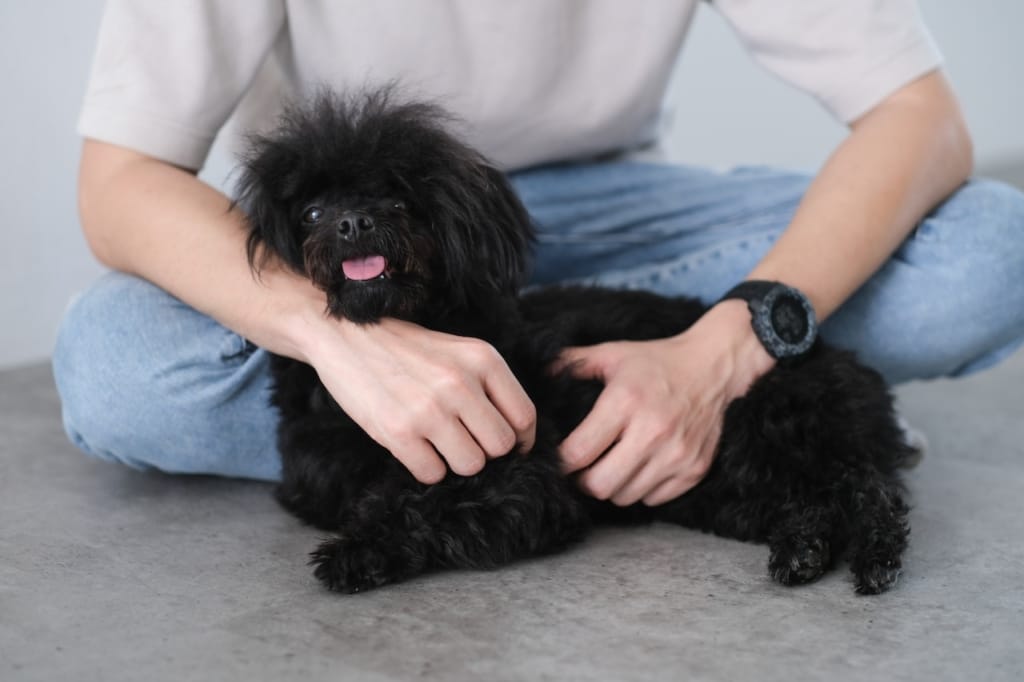Are Maltese dogs ever black? It's a common question that many prospective pet owners ask when considering this adorable and fluffy breed. While the Maltese is typically known for its luxurious white coat, it is possible for them to have black markings. These markings can appear on their ears, nose, or even their entire body. However, it's important to note that purebred Maltese dogs should not have a solid black coat. If you come across a Maltese claiming to be completely black, it is likely a mixed breed or a result of crossbreeding.

The black markings on a Maltese's coat can be traced back to their genetic background and ancestry. These distinctive markings add a touch of uniqueness to these already captivating little pups. Whether you prefer the classic all-white look or are drawn to the charm of a Maltese with black markings, both versions are equally adorable and make wonderful companions.
The standard color of Maltese dogs
Maltese dogs are known for their stunning all-white coat, which is one of their most defining characteristics. This breed is recognized by various kennel clubs, including the American Kennel Club (AKC) and the United Kennel Club (UKC), as having a solid white coat. The white color is considered the standard and is highly desirable among Maltese enthusiasts. The coat is long, silky, and straight, giving the Maltese an elegant and regal appearance. The white color not only adds to their beauty but also makes them stand out in a crowd. It is the hallmark of the breed and what most people envision when they think of a Maltese.
However, even though the white coat is the breed standard, there are instances where Maltese dogs can have markings of other colors, including black. These markings can vary in size, shape, and location on the dog's body. They can be as small as a dot or cover a larger area, such as the ears or the entire body. While these markings may deviate from the breed standard, they are still considered acceptable and can add a unique touch to the Maltese's appearance.

Can Maltese dogs be black?
While Maltese dogs can have black markings, it's important to clarify that a purebred Maltese should not have a solid black coat. The breed standard for Maltese dogs explicitly states that their coat should be pure white. This means that if you come across a Maltese claiming to be completely black, it is likely a mixed breed or a result of crossbreeding. This is not to say that mixed breed Maltese dogs are any less lovable or deserving of a forever home, but it's essential to understand the distinction between a purebred Maltese and a mixed breed.
The black markings that can appear on a Maltese's coat are often a result of their genetic background and ancestry. Many Maltese dogs have ancestors with black or parti-colored coats, and these genes can be passed down through generations. The black markings can manifest in various ways, such as patches on the ears, a black nose, or even a combination of black and white on the body. These markings are considered acceptable as long as they do not dominate the dog's overall appearance and are not present in a solid, all-black coat.
Genetics and coat color variations in Maltese dogs
To understand why some Maltese dogs have black markings, it's essential to delve into their genetics and coat color variations. The coat color of a dog is determined by the presence or absence of certain genes. In the case of Maltese dogs, the gene responsible for the white coat color is dominant. As a result, most purebred Maltese dogs will have a white coat. However, there are recessive genes that can influence the coat color, such as the gene responsible for black markings.
When two Maltese dogs with black marking genes are bred together, there is a possibility of producing puppies with black markings. These genes can be inherited from one or both parents, depending on their genetic makeup. While the white coat color is still the most common outcome, the presence of black markings is a testament to the genetic diversity within the breed. It is worth noting that breeding for specific coat color variations should always be done responsibly and with the welfare of the dogs in mind.
Common misconceptions about black Maltese dogs
The presence of black markings on a Maltese's coat has led to some misconceptions about the breed. One common misconception is that black Maltese dogs are more prone to health issues or have a lower quality compared to their all-white counterparts. However, there is no scientific evidence to support this claim. The presence of black markings does not affect the overall health or quality of a Maltese dog. It is merely a variation in coat color that adds to their individuality.
Another misconception is that black Maltese dogs are harder to groom or maintain compared to white Maltese dogs. While it's true that dark-colored coats can sometimes show dirt or stains more easily, proper grooming and regular bathing can keep a black Maltese looking clean and beautiful. With proper care and attention, a black Maltese can have a coat that is just as stunning as a white Maltese.
Other coat color variations in Maltese dogs

In addition to black markings, there are other coat color variations that can be found in Maltese dogs. These variations are also considered acceptable within the breed standard. One such variation is the parti-colored coat, which consists of patches of white and another color, such as black or brown. Parti-colored Maltese dogs can have unique and eye-catching patterns, with each dog being truly one of a kind.
Another coat color variation is the cream or ivory color. While these colors may not be as common as the classic white, they are still considered acceptable within the breed standard. Cream-colored Maltese dogs can have a slightly darker shade compared to the pure white coat, giving them a warm and elegant appearance.
How to identify a black Maltese dog
If you are specifically looking for a black Maltese dog, it's important to be able to identify one. Black markings on a Maltese's coat can vary in size and location, but there are some common characteristics to look out for. One of the most distinct features of a black Maltese is the presence of black on the ears. This can range from small patches to fully black ears. Another area where black markings can be found is the nose. Some black Maltese dogs have a black nose, which adds a touch of contrast to their overall appearance. It's also possible for a black Maltese to have black markings on other parts of the body, such as the back or tail.
It's important to note that the presence of black markings should not overshadow the overall appearance of a Maltese. A black Maltese should still have the characteristic white coat, with the black markings complementing their look rather than dominating it. When identifying a black Maltese, it's essential to consider the balance and harmony of their coat color.
Tips for caring for a black Maltese dog
Caring for a black Maltese dog is similar to caring for any other Maltese. Here are some tips to ensure your black Maltese stays healthy and happy:
- Grooming: Regular grooming is essential for maintaining a black Maltese's coat. Brushing their hair daily will help prevent tangling and matting. Additionally, regular baths with a high-quality best dog shampoo will keep their coat clean and free from dirt or stains.
- Sun protection: Dark-colored coats can absorb more heat from the sun, so it's important to protect your black Maltese from excessive sun exposure. Avoid walking them during the hottest hours of the day and provide them with shade or a sun hat when outdoors.
- Dental care: Just like any other dog, dental care is vital for a black Maltese's overall health. Brush their teeth regularly and consider providing them with dental chews or interactive dog toys to promote good oral hygiene.
- Exercise and mental stimulation: Black Maltese dogs, like all Maltese, are energetic and intelligent. Provide them with regular exercise and mental stimulation to keep them happy and prevent boredom.
- Regular veterinary check-ups: Schedule regular visits to the veterinarian to ensure your black Maltese receives the necessary vaccinations, preventive care, and any required medical treatments.

Finding a black Maltese dog for adoption or purchase
If you are specifically looking for a black Maltese dog, there are several options available. One option is to search for reputable breeders who specialize in breeding Maltese dogs with black markings. These breeders should be able to provide you with information about the dog's lineage and ensure that the breeding practices are ethical and responsible.
Another option is to consider adopting a black Maltese from a rescue or shelter. Many mixed breed Maltese dogs with black markings are in need of loving homes. By adopting, you not only give a dog a second chance at a happy life but also support the mission of rescuing and rehoming animals in need.
When adopting or purchasing a black Maltese dog, it's important to do thorough research and choose a reputable source. Ensure that the happy dog has received proper care, vaccinations, and has had a health check-up by a veterinarian. Responsible breeders and shelters will provide you with all the necessary information and documentation to ensure the well-being of the dog.
Conclusion
In conclusion, while the Maltese breed is typically known for its luxurious white coat, it is possible for them to have black markings. These black markings add a touch of uniqueness to these already captivating little pups. However, it's important to note that purebred Maltese dogs should not have a solid black coat. The presence of black markings can be traced back to their genetic background and ancestry. These variations in coat color add to the beauty and individuality of each Maltese dog.
Whether you prefer the classic all-white look or are drawn to the charm of a Maltese with black markings, both versions are equally adorable and make wonderful companions. Regardless of their coat color, Maltese dogs are known for their friendly and affectionate nature. So, whether you choose a white Maltese, a black Maltese with distinctive markings, or any other coat color variation, you can be sure that you'll have a loyal and loving companion by your side.
FAQs

- Can Maltese dogs be black?
No, the Maltese breed typically does not come in black. The breed standard recognizes only pure white as an acceptable coat color. - Are there any exceptions to the coat color in Maltese dogs?
While pure white is the standard, some Maltese dogs may have slight lemon or tan markings. However, black is not considered a standard or accepted color for this breed. - Why is black not a recognised colour for Maltese dogs?
The breed standard for Maltese dogs emphasizes a solid, pure white coat. Black is not considered within the acceptable range, and breeding for this colour is discouraged. - Are there any health concerns associated with black Maltese dogs?
There are no specific health concerns associated with black coat colour in Maltese dogs. However, responsible breeding practices should always be prioritized to ensure overall health and well-being. - Can a Maltese dog have black markings on its coat?
While slight lemon or tan markings are permissible, black markings are not characteristic of the Maltese breed. Any significant deviation from the breed standard may indicate a mixed or non-purebred Maltese. - Do black Maltese dogs exist due to crossbreeding?
In some cases, black Maltese-like dogs may result from crossbreeding with other breeds that carry the black coat gene. However, this is not standard for purebred Maltese dogs. - Are there any variations in coat colour within the Maltese breed?
The Maltese breed is known for its consistent white coat. While minor variations in shading may occur, black is not considered a natural or accepted variation. - Can coat colour change as Maltese dogs age?
Maltese puppies are typically born with a slightly off-white coat that gradually lightens to pure white as they mature. However, black is not a normal part of this colour transition. - Are there reputable breeders producing black Maltese dogs?
Reputable breeders adhere to breed standards, and intentionally breeding for black Maltese dogs is not common or encouraged within responsible breeding circles. - What steps should be taken if someone encounters a black Maltese-like dog?
If a Maltese-like dog exhibits a black coat, it may not be a purebred Maltese. If considering adoption or purchase, it is advisable to consult with a reputable breeder or rescue organization to ensure the dog's health and pedigree.




